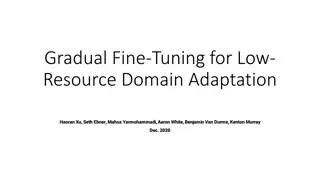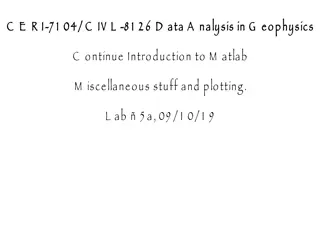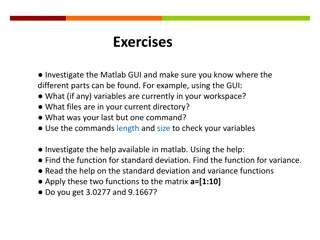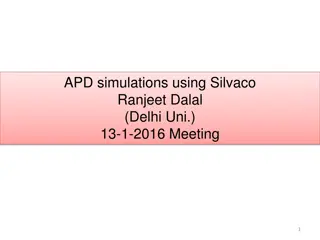Tuning MATLAB for Better Performance
In this set of materials, explore how to optimize MATLAB for enhanced performance. Discover strategies, examples, and tools to boost efficiency in MATLAB programming and computation, covering aspects like memory access, array allocation, parallel computing, and more.
Download Presentation

Please find below an Image/Link to download the presentation.
The content on the website is provided AS IS for your information and personal use only. It may not be sold, licensed, or shared on other websites without obtaining consent from the author.If you encounter any issues during the download, it is possible that the publisher has removed the file from their server.
You are allowed to download the files provided on this website for personal or commercial use, subject to the condition that they are used lawfully. All files are the property of their respective owners.
The content on the website is provided AS IS for your information and personal use only. It may not be sold, licensed, or shared on other websites without obtaining consent from the author.
E N D
Presentation Transcript
TUNING MATLAB FOR BETTER PERFORMANCE Kadin Tseng Boston University Scientific Computing and Visualization
2 Tuning MATLAB for Better Performance Where to Find Performance Gains ? Serial Performance gain Due to memory access Due to caching Due to vector representations Due to compiler Due to other ways Parallel performance gain is covered in the MATLAB Parallel Computing Toolbox tutorial
3 Tuning MATLAB for Better Performance Performance Issues Related to Memory Access
4 Tuning MATLAB for Better Performance How Does MATLAB Allocate Arrays ? Each MATLAB array is allocated in contiguous address space. What happens if you don t preallocate array x ? Memory Address 1 2000 2001 2002 2003 2004 . . . 10004 10005 10006 10007 Array Element x(1) . . . x(1) x(2) x(1) x(2) x(3) . . . x(1) x(2) x(3) x(4) x = 1; for i=2:4 x(i) = i; end To satisfy contiguous memory placement rule, x may need to be moved from one memory segment to another many times during iteration process.
5 Tuning MATLAB for Better Performance Always preallocate array before using it Preallocating array to its maximum size prevents all intermediate array movement and copying described. >> A=zeros(n,m); % initialize A to 0 >> A(n,m)=0; % or touch largest element If maximum size is not known apriori, estimate with upperbound. Remove unused memory after. >> A=rand(100,100); >> % . . . >> % if final size is 60x40, remove unused portion >> A(61:end,:)=[]; A(:,41:end)=[]; % delete
6 Tuning MATLAB for Better Performance Example For efficiency considerations, MATLAB arrays are allocated in contiguous memory space. A preallocated array avoids data copy. Bad: Good: n=5000; tic for i=1:n x(i) = i^2; end toc Wallclock time = 0.00046 seconds n=5000; x = zeros(n, 1); tic for i=1:n x(i) = i^2; end toc Wallclock time = 0.00004 seconds not_allocate.m allocate.m The timing data are recorded on Katana. The actual times on your computer may vary depending on the processor.
7 Tuning MATLAB for Better Performance Lazy Copy MATLAB uses pass-by-reference if passed array is used without changes; a copy will be made if the array is modified. MATLAB calls it lazy copy. Example: function y = lazyCopy(A, x, b, change) If change, A(2,3) = 23; end % forces a local copy of a y = A*x + b; % use x and b directly from calling program pause(2) % keep memory longer to see it in Task Manager On Windows, use Task Manager to monitormemory allocation history. >> n = 5000; A = rand(n); x = rand(n,1); b = rand(n,1); >> y = lazyCopy(A, x, b, 0); % no copy; pass by reference >> y = lazyCopy(A, x, b, 1); % copy; pass by value
8 Tuning MATLAB for Better Performance Performance Issues Related to Caching
9 Code Tuning and Optimization Cache Cache is a small chunk of fast memory between the main memory and the registers registers primary cache secondary cache main memory
10 Code Tuning and Optimization Cache (2) If variables are fetched from cache, code will run faster since cache memory is much faster than main memory Variables are moved from main memory to cache in lines L1 cache line sizes on our machines Opteron (katana cluster) 64 bytes Xeon (katana cluster) 64 bytes Power4 (p-series) 128 bytes PPC440 (Blue Gene) 32 bytes
11 Code Tuning and Optimization Cache (3) Why not just make the main memory out of the same stuff as cache? Expensive Runs hot This was actually done in Cray computers Liquid cooling system Currently, special clusters (on XSEDE.org) available with very substantial flash main memory for I/O-bound applications
12 Code Tuning and Optimization Cache (4) Cache hit Required variable is in cache Cache miss Required variable not in cache If cache is full, something else must be thrown out (sent back to main memory) to make room Want to minimize number of cache misses
13 Code Tuning and Optimization Cache (5) mini cache holds 2 lines, 4 words each for i=1:10 x(i) = i; end x(9) x(10) x(1) x(2) x(3) x(4) x(5) x(6) a b Main memory x(7) x(8)
14 Code Tuning and Optimization Cache (6) will ignore i for simplicity need x(1), not in cache load line from memory into cache next 3 loop indices result in cache hits x(1) cache miss x(2) x(3) x(4) for i=1:10 x(i) = i; end x(9) x(10) x(1) x(2) x(3) x(4) x(5) x(6) a b x(7) x(8)
15 Code Tuning and Optimization Cache (7) need x(5), not in cache cache miss load line from memory into cache free ride next 3 loop indices hits x(1) x(5) x(2) x(3) x(4) x(6) cache x(7) x(8) for i=1:10 x(i) = i; end x(9) x(10) x(1) x(2) x(3) x(4) x(5) x(6) a b x(7) x(8)
16 Code Tuning and Optimization Cache (8) need x(9), not in cache --> cache miss load line from memory into cache no room in cache! replace old line x(9) x(5) x(6) x(10) a b x(7) x(8) for i=1:10 x(i) = i; end x(9) x(1) x(10) x(2) x(3) x(4) x(5) x(6) a b x(7) x(8)
17 Code Tuning and Optimization Cache (9) Multidimensional array is stored in column-major order: x(1,1) x(2,1) x(3,1) . . x(1,2) x(2,2) x(3,2) . .
18 Tuning MATLAB for Better Performance For-loop Order Best if inner-most loop is for array left-most index, etc. (column- major) Bad: Good: n=5000; x = zeros(n); for i = 1:n % rows for j = 1:n % columns x(i,j) = i+(j-1)*n; end end n=5000; x = zeros(n); for j = 1:n % columns for i = 1:n % rows x(i,j) = i+(j-1)*n; end end Wallclock time = 0.88 seconds Wallclock time = 0.48 seconds forij.m forji.m For a multi-dimensional array, x(i,j), the 1D representation of the same array, x(k), follows column-wise order and inherently possesses the contiguous property
19 Tuning MATLAB for Better Performance Compute In-place Compute and save array in-place improves performance and reduces memory usage Bad: Good: x = rand(5000); tic y = x.^2; toc x = rand(5000); tic x = x.^2; toc Wallclock time = 0.30 seconds Wallclock time = 0.11 seconds not_inplace.m inplace.m Caveat: May not be worthwhile if it involves data type or size changes
20 Code Tuning and Optimization Eliminate redundant operations in loops Bad: for i=1:N x = 10; . . end x = 10; for i=1:N . end Good: . Better performance to use vector than loops
21 Code Tuning and Optimization Loop Fusion for i=1:N x(i) = i; end for i=1:N y(i) = rand(); end Bad: for i=1:N x(i) = i; y(i) = rand(); end Good: Reduces for-loop overhead More important, improve chances of pipelining Loop fisssion splits statements into multiple loops
22 Code Tuning and Optimization Avoid if statements within loops for i=1:N Bad: if has overhead cost and may inhibit pipelining if i == 1 %perform i=1 calculations else %perform i>1 calculations end end Good: %perform i=1 calculations for i=2:N %perform i>1 calculations end
23 Code Tuning and Optimization Divide is more expensive than multiply Intel x86 clock cycles per operation add 3-6 multiply 4-8 divide 32-45 c = 4; Bad: for i=1:N x(i)=y(i)/c; end s = 1/c; Good: for i=1:N x(i) = y(i)*s; end
24 Code Tuning and Optimization Function Call Overhead function myfunc(i) for i=1:N Bad: do stuff myfunc(i); end end Good: myfunc2(N); function myfunc2(N) for i=1:N do stuff end end Function m-file is precompiled to lower overhead for repeated usage. Still, there is an overhead . Balance between modularity and performance.
25 Code Tuning and Optimization Minimize calls to math & arithmetic operations Bad: for i=1:N z(i) = log(x(i)) * log(y(i)); v(i) = x(i) + x(i)^2 + x(i)^3; end Good: for i=1:N z(i) = log(x(i) + y(i)); v(i) = x(i)*(1+x(i)*(1+x(i))); end
26 Tuning MATLAB for Better Performance Special Functions for Real Numbers MATLAB provides a few functions for processing real number specifically. These functions are more efficient than their generic versions: realpow power for real numbers realsqrt square root for real numbers reallog logarithm for real numbers realmin/realmax min/max for real numbers n = 1000; x = 1:n; x = x.^2; tic x = sqrt(x); toc n = 1000; x = 1:n; x = x.^2; tic x = realsqrt(x); toc Wallclock time = 0.00022 seconds Wallclock time = 0.00004 seconds square_root.m real_square_root.m isreal reports whether the array is real single/double converts data to single-, or double-precision
27 Tuning MATLAB for Better Performance Vector Is Better Than Loops MATLAB is designed for vector and matrix operations. The use of for-loop, in general, can be expensive, especially if the loop count is large and nested. Without array pre-allocation, its size extension in a for-loop is costly as shown before. When possible, use vector representation instead of for-loops. i = 0; for t = 0:.01:100 i = i + 1; y(i) = sin(t); end t = 0:.01:100; y = sin(t); Wallclock time = 0.1069 seconds Wallclock time = 0.0007 seconds for_sine.m vec_sine.m
28 Tuning MATLAB for Better Performance Vector Operations of Arrays >> A = magic(3) % define a 3x3 matrix A A = 8 1 6 3 5 7 4 9 2 >> B = A^2; % B = A * A; >> C = A + B; >> b = 1:3 % define b as a 1x3 row vector b = 1 2 3 >> [A, b'] % add b transpose as a 4th column to A ans = 8 1 6 1 3 5 7 2 4 9 2 3
29 Tuning MATLAB for Better Performance Vector Operations >> [A; b] % add b as a 4th row to A ans = 8 1 6 3 5 7 4 9 2 1 2 3 >> A = zeros(3) % zeros generates 3 x 3 array of 0 s A = 0 0 0 0 0 0 0 0 0 >> B = 2*ones(2,3) % ones generates 2 x 3 array of 1 s B = 2 2 2 2 2 2 Alternatively, >> B = repmat(2,2,3) % matrix replication
30 Tuning MATLAB for Better Performance Vector Operations >> y = (1:5) ; >> n = 3; >> B = y(:, ones(1,n)) % B = y(:, [1 1 1]) or B=[y y y] B = 1 1 1 2 2 2 3 3 3 4 4 4 5 5 5 Again, B can be generated via repmat as >> B = repmat(y, 1, 3);
31 Tuning MATLAB for Better Performance Vector Operations >> A = magic(3) A = 8 1 6 3 5 7 4 9 2 >> B = A(:, [1 3 2]) % switch 2nd and third columns of A B = 8 6 1 3 7 5 4 2 9 >> A(:, 2) = [ ] % delete second column of A A = 8 6 3 7 4 2
32 Tuning MATLAB for Better Performance Vector Utility Functions Function all any zeros ones repmat find diff squeeze prod sum cumsum shiftdim logical Sort Description Test to see if all elements are of a prescribed value Test to see if any element is of a prescribed value Create array of zeroes Create array of ones Replicate and tile an array Find indices and values of nonzero elements Find differences and approximate derivatives Remove singleton dimensions from an array Find product of array elements Find the sum of array elements Find cumulative sum Shift array dimensions Convert numeric values to logical Sort array elements in ascending /descending order
33 Tuning MATLAB for Better Performance Integration Example ? Integral is area under cosine function in range of 0 to /2 Equals to sum of all rectangles (width times height of bars) m m + b a ih = = = + cos( ) cos( ) cos( ( ) ) x dx x dx a i h h 1 2 + ) 1 ( a a i h 1 1 i i a = 0; b = pi/2; % range m = 8; % # of increments h = (b-a)/m; % increment cos(x) h mid-point of increment
34 Tuning MATLAB for Better Performance Integration Example using for-loop % integration with for-loop tic m = 100; a = 0; % lower limit of integration b = pi/2; % upper limit of integration h = (b a)/m; % increment length integral = 0; % initialize integral for i=1:m x = a+(i-0.5)*h; % mid-point of increment i integral = integral + cos(x)*h; end toc h a b X(1) = a + h/2 X(m) = b - h/2
35 Tuning MATLAB for Better Performance Integration Example using vector form % integration with vector form tic m = 100; a = 0; % lower limit of integration b = pi/2; % upper limit of integration h = (b a)/m; % increment length x = a+h/2:h:b-h/2; % mid-point of m increments integral = sum(cos(x))*h; toc h a b X(1) = a + h/2 X(m) = b - h/2
36 Tuning MATLAB for Better Performance Integration Example Benchmarks increment m for-loop Vector 10000 0.00044 0.00017 20000 0.00087 0.00032 40000 0.00176 0.00064 80000 0.00346 0.00130 160000 0.00712 0.00322 320000 0.01434 0.00663 Timings (seconds) obtained on Intel Core i5 3.2 GHz PC Computational effort linearly proportional to # of increments.
37 Tuning MATLAB for Better Performance Laplace Equation (Steady incompressible potential flow) u x 2 2 u 2 + = 0 2 y Boundary Conditions: = ( , ) ( ) u x sin x x 0 0 1 = ( , ) ( ) u x sin x e = x 1 y 0 1 = ( , ) ( , ) u u y y 0 1 0 0 1 Analytical solution: = ) ( y ( , ) u x y sin x e 0 x 1; 0 y 1
38 Tuning MATLAB for Better Performance Finite Difference Numerical Discretization Discretize equation by centered-difference yields: + + , + n i n i n i,j n i,j u u u u + + +1 1,j 1,j 1 1 = = n i u i m; , j m , 1,2, 1,2, j 4 where n and n+1 denote the current and the next time step, respectively, while = = = n i,j n u u (x ,y ) i m , ; j m + + 0,1,2, 1 0,1,2, , 1 i j = n , ) u (i x j y For simplicity, we take 1 + = = x y m 1
39 Tuning MATLAB for Better Performance Computational Domain = e x sin( ) u(x,1 ) y, j x, i u(1,y) = 0 u(0,y) = 0 u ( x , ) = sin ( x ) 0 n i n i n i,j n i,j u + u + u + u + 1,j 1,j + 1 1 n i , + 1 u i = 1,2, ,m; j = 1,2, ,m j 4
40 Tuning MATLAB for Better Performance Five-point Finite-difference Stencil Interior cells. x x o Where solution of the Laplace equation is sought. x x x Exterior cells. Green cells denote cells where homogeneous boundary conditions are imposed while non-homogeneous boundary conditions are colored in blue. x o x x x
41 Tuning MATLAB for Better Performance SOR Update Function How to vectorize it ? 1. Remove the for-loops 2. Define i = ib:2:ie; 3. Define j = jb:2:je; 4. Use sum for del % original code fragment jb = 2; je = n+1; ib = 3; ie = m+1; for i=ib:2:ie for j=jb:2:je up = ( u(i ,j+1) + u(i+1,j ) + ... u(i-1,j ) + u(i ,j-1) )*0.25; u(i,j) = (1.0 - omega)*u(i,j) +omega*up; del = del + abs(up-u(i,j)); end end % equivalent vector code fragment jb = 2; je = n+1; ib = 3; ie = m+1; i = ib:2:ie; j = jb:2:je; up = ( u(i ,j+1) + u(i+1,j ) + ... u(i-1,j ) + u(i ,j-1) )*0.25; u(i,j) = (1.0 - omega)*u(i,j) + omega*up; del = sum(sum(abs(up-u(i,j))));
42 Tuning MATLAB for Better Performance Solution Contour Plot
43 Tuning MATLAB for Better Performance SOR Timing Benchmarks
44 Tuning MATLAB for Better Performance Summation For global sum of 2D matrices: sum(sum(A)) or sum(A(:)) Example: which is more efficient ? A = rand(1000); tic,sum(sum(A)),toc tic,sum(A(:)),toc No appreciable performance difference; latter more compact. Your application calls for summing a matrix along rows (dim=2) multiple times (inside a loop). Example: A = rand(1000); tic, for t=1:100,sum(A,2);end, toc MATLAB matrix memory ordering is by column. Better performance if sum by column. Swap the two indices of A at the outset. Example: B=A ; tic, for t=1:100, sum(B,1);end, toc (See twosums.m)
45 Tuning MATLAB for Better Performance Other Tips Generally better to use function rather than script Script m-file is loaded into memory and evaluate one line at a time. Subsequent uses require reloading. Function m-file is compiled into a pseudo-code and is loaded on first application. Subsequent uses of the function will be faster without reloading. Function is modular; self cleaning; reusable. Global variables are expensive; difficult to track. Don t reassign array that results in change of data type or shape Limit m-files size and complexity Structure of arrays more memory-efficient than array of structures
46 Tuning MATLAB for Better Performance Memory Management Maximize memory availability. 32-bit systems < 2 or 3 GB 64-bit systems running 32-bit MATLAB < 4GB 64-bit systems running 64-bit MATLAB < 8TB (96 GB on some Katana nodes) Minimize memory usage. (Details to follow )
47 Tuning MATLAB for Better Performance Minimize Memory Usage Use clear, pack or other memory saving means when possible. If double precision (default) is not required, the use of single data type could save substantial amount of memory. For example, >> x=ones(10,'single'); y=x+1; % y inherits single from x Use sparse to reduce memory footprint on sparse matrices >> n=3000; A = zeros(n); A(3,2) = 1; B = ones(n); >> tic, C = A*B; toc % 6 secs >> As = sparse(A); >> tic, D = As*B; toc % 0.12 secs; D not sparse Be aware that array of structures uses more memory than structure of arrays. (pre-allocation is good practice too for structs!)
48 Tuning MATLAB for Better Performance Minimize Memory Uage For batch jobs, use matlab nojvm saves lots of memory Memory usage query For Linux: Katana% top For Windows: >> m = feature('memstats'); % largest contiguous free block Use MS Windows Task Manager to monitor memory allocation. On multiprocessor systems, distribute memory among processors
49 Tuning MATLAB for Better Performance Compilers mcc is a MATLAB compiler: It compiles m-files into C codes, object libraries, or stand-alone executables. A stand-alone executable generated with mcc can run on compatible platforms without an installed MATLAB or a MATLAB license. On special occasions, MATLAB access may be denied if all licenses are checked out. Running a stand-alone requires NO licenses and no waiting. It is not meant to facilitate any performance gains. coder m-file to C code converter
50 Tuning MATLAB for Better Performance mcc example How to build a standalone executable on Windows >> mcc o twosums m twosums How to run executable on Windows Command Promp (dos) Command prompt:> twosums 3000 2000 Details: twosums.m is a function m-file with 2 input arguments Input arguments to code are processed as strings by mcc. Convert with str2double: if isdeployed, N=str2double(N); end Output cannot be returned; either save to file or display on screen. The executable is twosums.exe























